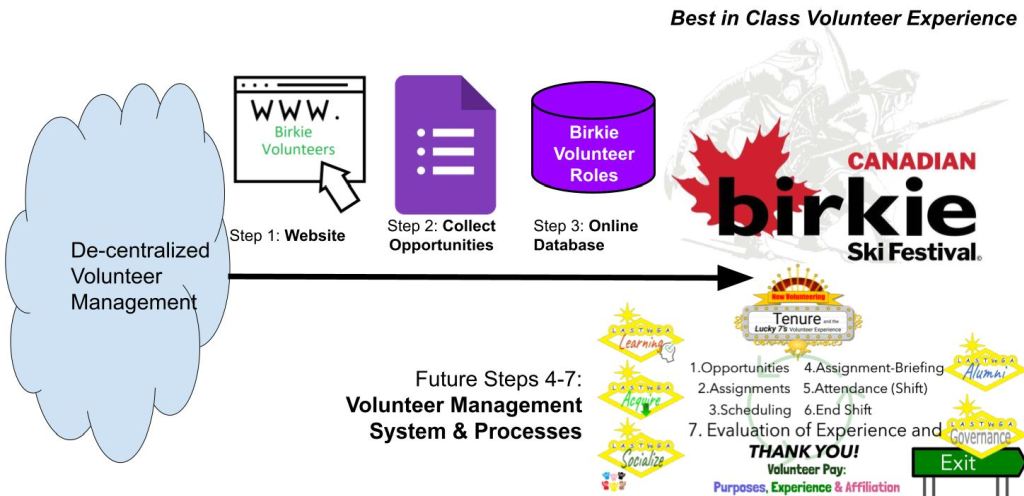The first in a (hopefully) series of how the Canadian Birkebeiner can create a best in class in experience for its 500+ volunteers.

Birch Bark and the Origin of The Birkie
Birkebeiners (Birchbarkleggers) got their name from wrapping and tying birch bark around their legs from the knees down, similar to gaiters. This kept the snow out and protected their legs in battle. Today, Birkebeiner has come to mean a person strong in adversity, never daunted by trial and hardships.
The dramatic flight of the Birchlegs and the Infant King is commemorated every year by the Norwegian Birkebeinerrennet ski race which parallels the historic route over the mountains between Lillehammer and Rena.[1]
The Canadian Birkebeiner (‘Birkie’) is a sister event to the Norwegian ski race (with a third Birkebeiner hosted in Wisconsin). The Birkie takes place at Cooking Lake-Blackfoot Provincial Recreation Area which boasts a legendary cross-country ski trail system. Modern day Birkebeiners ski the long distance events from Ukrainian Cultural Heritage Village, a provincial historic site on Highway 16, through Elk Island National Park, to the Blackfoot Provincial Recreation Area.[1]
The 500+ Volunteer Challenge
The Birkie relies on 500+ volunteers to support 1,200+ cross country skiers in multiple events. Over the nearly 40 years of the Birkie’s existence, it has had a passionate and strong volunteer cadre. Demographic changes means finding 500 able, willing, and trained souls becomes an ever more daunting challenge.
The Birkie has at its disposal a Volunteer Lifecycle Model, a method to Categorize the Types of Volunteers it uses, and knowledge of what makes for a Good Volunteer Role Description Model.
The Birkie has traditionally decentrally managed its volunteers. While there is interest in implementing volunteer management systems to reduce The Burden of Volunteering, historical de-centralization has delayed the implementation.
Volunteer Management, One Step at a Time
With less than five months to go before the event, the Board of the Canadian Birkebeiner Society has approved a seven step approach to improving its volunteer management.
Each step provides incremental value and all will contribute to the implementation of a full scale, future system. The order is important as each step is a precursor to the next one. The Birkie does not have capacity to complete all steps prior to the 2024 event but will finish as many as possible.
- Dedicated Web Site. A free WordPress site will be created along with a dedicated GMail account. This will allow the volunteer activities to take place outside of the existing website, reducing access and technical challenges.
- Opportunity Submission Form. A form will collection volunteer role details from the Birkie. Submitters can also submit via a Google Sheet or Excel document.
- Opportunity Database. The above contributions will be collected into a Google Sheet which in turn can be queried and displayed on the website.
- Shift Schedule. The shift schedule including how many volunteers are needed is created and available on the website. Not real time, the schedule will be updated manually.
- Sign Up Form. Replacing an existing web/email form, individuals can complete an expression of interest and their details collected into a master list.
- Schedule Form. Volunteers who have registered can select a shift updating the schedule in real time.
- Attendance. The Birkie relies on grants and most granting agencies require the contribution of volunteer hours. This can be collected manually but typically results in under reporting. An attendance check will confirm hours worked by the volunteer.
Let’s Get Started!
Completing steps 1-3 and having an accurate picture of the various volunteer roles would be a major achievement for the Birkie. It is also a test to determine if the Birkie can overcome its cultural traditions of de-centralized volunteering.
Will it be successful? The only way to find out is to get started!
References and Further Reading
- Adapted from Birkie Legend, accessed 2023-10-14.

Pingback: Telling the Volunteer Story(ies) | Organizational Biology
Pingback: The Birkie Catalog of Opportunities | Organizational Biology
Pingback: Updating Pages – Birkie Volunteers